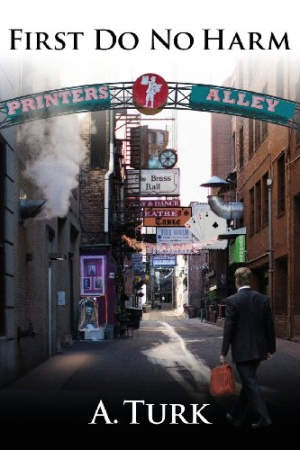First Do No Harm
The characters’ decisions and actions drive this story forward, capturing their motives in highly detailed prose.
The stakes are high and personal when a lawyer takes on two greedy doctors and finds himself battling a hospital more interested in profits than patients in this fast-paced, highly detailed, legal thriller.
Dr. Laura Patel of Plainview Community Hospital stumbles across a patient whose condition has been mishandled, and finds herself dismissed from the hospital for questioning the lead doctor. She goes to attorney Benjamin Davis. When he takes on the malpractice lawsuit against two doctors who he discovers have been purposefully misdiagnosing and operating on patients in order to reap financial profits, Davis finds his life in jeopardy.
With First Do No Harm, attorney-turned-author Alan Turk offers an intriguing and insightful behind-the-scenes look at criminal investigations, the court system, and their effects on personal lives. The plot is dynamic and the narrative somewhat crisp, especially in the fast-flowing opening chapters when Davis is beaten up by three assailants and Patel is faced with the truth that Dr. Herman’s negligence caused the death of a patient. The backstories of the diverse range of characters add to the plot’s intensity, as no-holds-barred tactics are used to achieve their goals. There’s Davis, who is determined to make a name for himself in Nashville’s sea of attorneys; desperate Dr. English, who is wanted for bailing on his child support duties; and defense attorney Amy Pierce, hungry for a partnership in her firm,
Turk’s thirty-some years of experience are evident in his detailed descriptions, which explain characters’ actions and decisions, leaving no confusion in the plot. However, explanations of the judicial process and the reasons behind various decisions, such as what makes a good juror, slow down the flow of the story and, because they are well known by readers of this genre, are not crucial to the plot: “In theory, the best juror was one with a clean slate, no predisposing attitude either for or against a party. In reality, each side wanted as many biased jurors to its side as possible.”
Some descriptions could be made more powerful with a change in tense and editing of awkward remarks, as in the action scene involving Davis’s niece, Sammie: “Hardy was riddled with bullets, and immediately, a pattern of red blotches, like paint, splattered across his white shirt. … Sammie was shaken. She had never seen anyone shot and killed before. She knew she would remember the scene the rest of her life.”
Occasionally, the first and second parts of a sentence seem inconsistent, as in the description of Davis in the emergency room: “John, a heart surgeon, quickly determined that Davis’s left shoulder was dislocated.” An edit to remove instances of repetitive character introductions would be helpful. For example, after Davis’s beating: “When they arrived at the emergency room, Liza and her father, John Caldwell, were waiting.” A few chapters later: “John Caldwell, Liza’s father and Morty’s heart surgeon, asked Morty and Davis if he could see them in private.”
First Do No Harm is an intriguing legal thriller offering detailed explanations into the workings of a court that may be especially insightful for new readers of the genre.
Reviewed by
Maya Fleischmann
Disclosure: This article is not an endorsement, but a review. The publisher of this book provided free copies of the book and paid a small fee to have their book reviewed by a professional reviewer. Foreword Reviews and Clarion Reviews make no guarantee that the publisher will receive a positive review. Foreword Magazine, Inc. is disclosing this in accordance with the Federal Trade Commission’s 16 CFR, Part 255.

